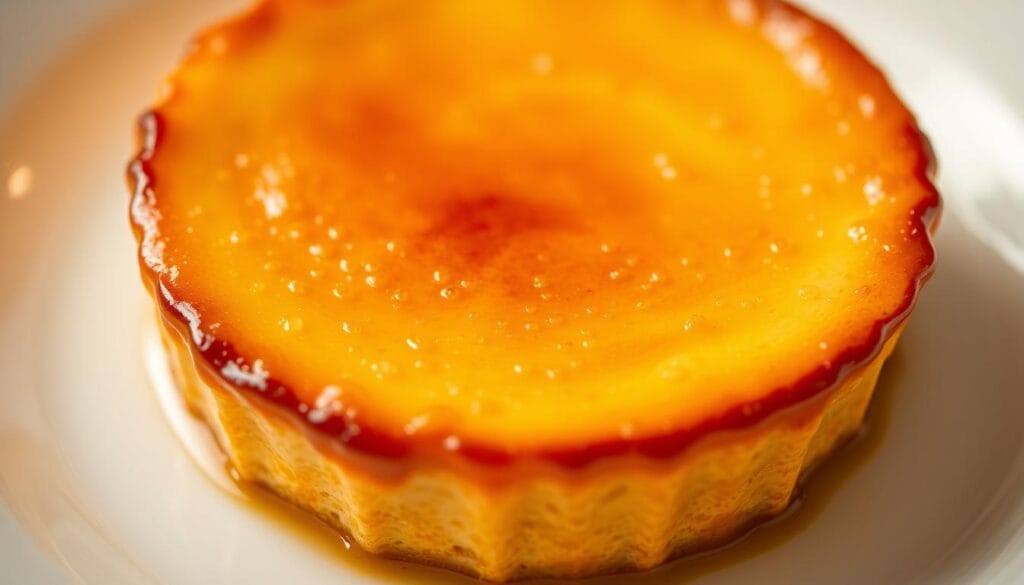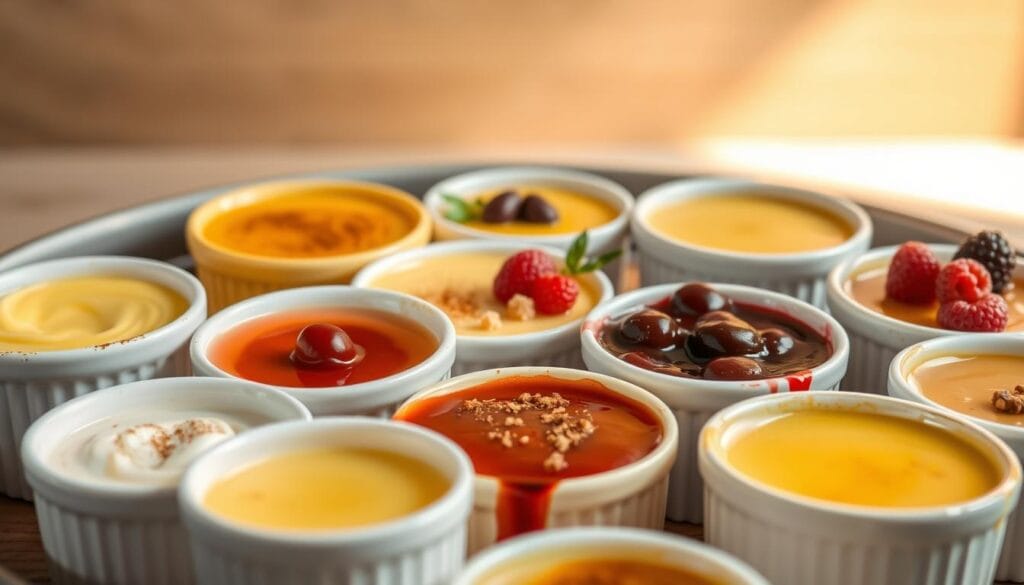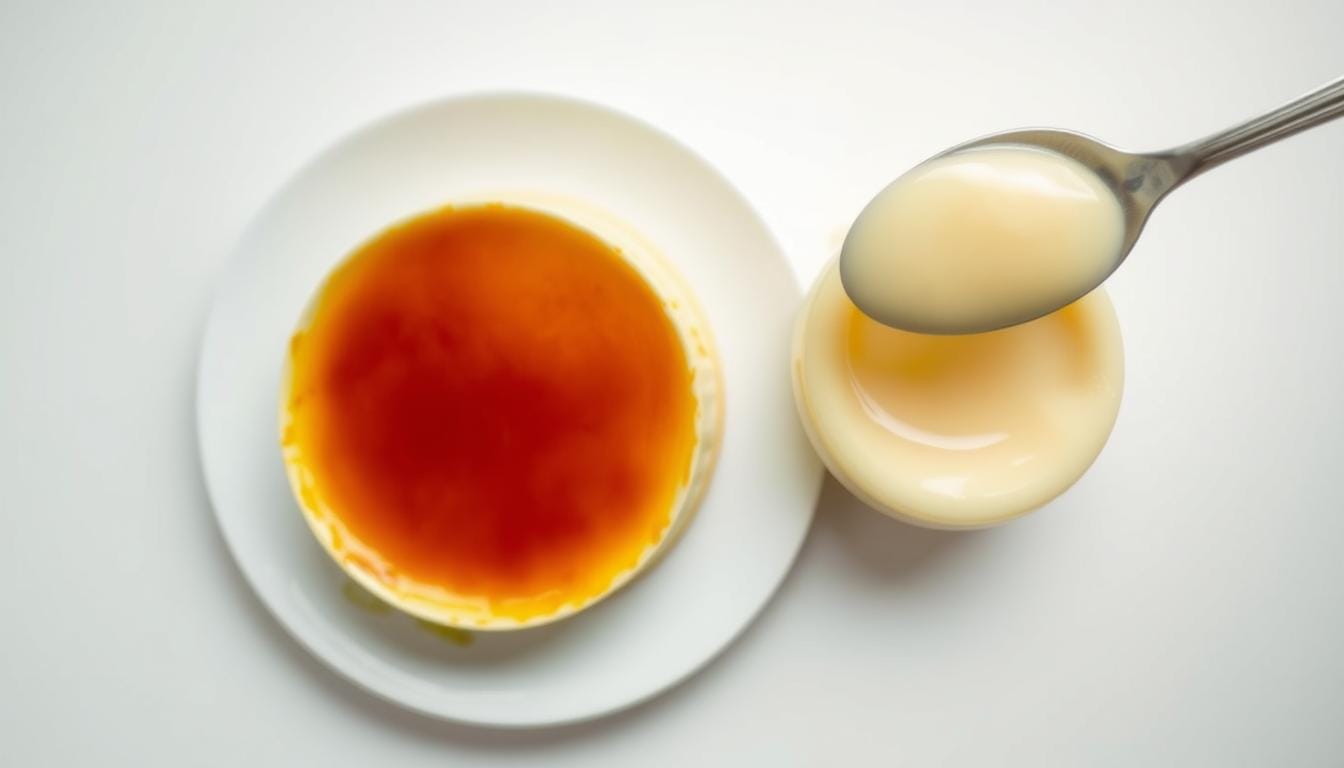Ever wondered why crème brûlée and custard are often mixed up? They both use eggs, cream, and sugar, but they’re very different. Let’s look at their textures, how they’re made, and tastes. This will help you see why crème brûlée and custard are not the same.
By learning about their history, making process, and flavors, you’ll understand the gap between them. It’s more than just a debate. It’s a celebration of the art of cooking.
Table of Contents
Understanding Crème Brûlée
Crème brûlée is a luxurious dessert known for its creamy texture and rich flavor. It has a delicate custard base topped with a caramelized layer. This combination creates a delightful contrast that dessert lovers adore.
Understanding crème brûlée is more than just enjoying it. It’s about mastering the preparation process. This process gives the dessert its unique character.
What is Crème Brûlée?
Crème brûlée is a rich custard dessert with a creamy filling and a caramelized top. It’s made with heavy cream, egg yolks, sugar, and vanilla. This mix creates a smooth flavor.
Many are fascinated by the history of crème brûlée. It’s believed to have originated in the late 17th century in French cuisine.
Ingredients of Crème Brûlée
The key to a perfect crème brûlée is in its ingredients. Essential Crème Brûlée ingredients include:
- 1 cup (250 ml) heavy cream
- 1 cup (250 ml) whole milk
- 4 large egg yolks
- ⅓ cup plus 2 tablespoons (approximately 85 grams) granulated white sugar
- 1 tablespoon vanilla extract
- 2 tablespoons white sugar + 1 tablespoon brown sugar for caramelization
The Signature Caramelized Top
The caramelized top is what makes crème brûlée special. During Crème Brûlée preparation, sugar is sprinkled on the custard. Then, it’s heated until it caramelizes.
This can be done with a broiler or a blowtorch. Both methods create a satisfying crack when served. For the best results, the topping should be under the broiler for 2 to 3 minutes.

Exploring Custard
Custard is a versatile dessert found in many cultures. It’s made from eggs and a liquid thickener like milk or cream. This makes it perfect for different uses, from sweet sauces to baked dishes.
What is Custard?
Custard is a mix of eggs, sugar, and milk or cream. The egg thickens it, so cooking is key to get it right. This dessert can be flavored and presented in many ways, showing its flexibility in cooking.
Common Ingredients in Custard
The basic ingredients are:
- Eggs
- Sugar
- Milk or cream
- Flavorings, like vanilla or citrus zest
These ingredients give custard its smooth texture and rich taste. You can also add chocolate or coffee to make it even more special.
Types of Custard
There are many types of custard, each with its own charm:
- Basic Custard (Crème Anglaise): A pourable sauce, often flavored with vanilla, great with cakes or fruit.
- Baked Custard: Cooked in a water bath, it’s firmer and keeps its shape, like in crème caramel and flan.
- Stirred Custard: Needs constant stirring on the stovetop to avoid curdling, making it thick for filling pastries, like pastry cream.
Each type of custard has its own use in cooking. Learning about them can lead to endless dessert creations.

Key Preparation Techniques
Learning how to make custard is key to making both crème brûlée and custard. While they share some steps, each dish has its own special touches. Knowing how to make these desserts will improve your cooking and please your taste buds.
How to Make Crème Brûlée
To make a classic crème brûlée, mix heavy cream, egg yolks, sugar, and vanilla in a saucepan. Heat it gently until it’s warm, but not boiling. Then, pour it into ramekins and place them in a baking dish with hot water.
This water bath is important for even cooking. It keeps the temperature steady, below 212°F (100°C). Bake at 300°F (149°C) for 25-30 minutes. The custard should slightly jiggle in the center when done.
Let the ramekins cool, then refrigerate them for 4 hours or overnight. Before serving, sprinkle sugar on top and caramelize it with a torch or broiler. This adds the crunchy layer that makes crème brûlée so good.
How to Make Custard
To make basic custard, whisk egg yolks and sugar until smooth. Slowly add warm milk, stirring constantly. Heat it gently until it thickens, without boiling.
For baked custard, use the water bath method for even cooking. Bake until the edges are set and the center is slightly jiggly. This method can make different types of custard, like flan or pastries.
| Technique | Crème Brûlée | Custard |
|---|---|---|
| Main Ingredients | Heavy cream, egg yolks, sugar, vanilla | Egg yolks, sugar, milk, flavorings |
| Cooking Method | Baked in a water bath | Can be stirred or baked |
| Setting Temperature | 300°F (149°C) | Varies, usually not exceeding 212°F (100°C) |
| Serving Style | Individual ramekins | Baked in a dish or individual molds |
The Texture Differences
Crème brûlée and custard have unique textures that make them special. Each dessert offers a different look and feel. This can really make your dessert time better.
Crème Brûlée’s Creamy Consistency
Crème Brûlée is known for its creamy custard base. It has a thin, crispy caramelized layer on top. This mix of textures is amazing, with the burnt sugar giving way to smooth custard.
The way it’s made, baking in a water bath, is key. It keeps the custard silky and prevents it from curdling. This makes the dessert feel luxurious.
Custard’s Versatile Texture
Custard can be many things, from thick and sliceable to pourable. Its texture changes based on what thickens it, like egg yolks or cornstarch. Some custards stay soft, while others get firmer as they cook.
This flexibility lets custard be used in many ways. It can be served in different ways, meeting various tastes and needs.
Flavor Profiles
Dessert flavors are key, and this is true for crème brûlée and custard. Crème brûlée has a rich, sweet vanilla base. It also has a caramelized sugar top that adds a unique bitterness. This mix makes it a luxurious treat that many love.
Custard, on the other hand, offers many flavor options. It often has vanilla, but you can also add chocolate, coffee, or fruit. Spices like cinnamon or nutmeg can be used too. This makes custard great for desserts and even as a filling for pastries.
Looking at these flavors, crème brûlée is known for its indulgent taste. Custard, with its many flavors, is more versatile. Your choice depends on whether you prefer a rich dessert or something lighter and more adaptable.
Cooking Methods
Learning about different cooking methods is key for making desserts like Baking Crème Brûlée and custard. These methods affect the texture and taste, making the dessert enjoyable to eat.
Baking Crème Brûlée
Baking Crème Brûlée needs careful steps. First, you make a custard mix and put it in ramekins. Then, it goes into a water bath for even cooking.
This method makes the Crème Brûlée firm yet creamy. The caramelized sugar on top adds a nice crunch. Chilling it for at least four hours improves the taste, making it perfect for special events.
Stovetop vs. Oven for Custard
For custard, you can use the stovetop or oven. Stovetop custard needs constant stirring to prevent it from becoming lumpy. It turns out smooth and pourable.
Oven-baked custards also need a water bath but are firmer. These methods let you make custards that are smooth or thick, great for pies. Each way brings out different flavors, making custard a flexible dessert choice.
Serving Suggestions
When serving Crème Brûlée and custard, how you present them matters a lot. The way you serve these desserts can make them taste even better. It shows off their special qualities.
Best Ways to Serve Crème Brûlée
Serving Crème Brûlée needs careful attention. It’s usually served in wide, shallow ramekins. This lets you get a perfect caramelized top.
Right after caramelizing, it’s best to enjoy it. You can add fresh berries or whipped cream. They add a nice contrast to the rich custard.
Serving Custard: Hot vs. Cold
Custard can be served hot or cold, depending on what you like. Custard best practices say baked custards are best warm. They feel comforting and rich.
Stirred custards are great chilled, paired with pastries or cakes. You can garnish with chocolate shavings, fruit compotes, or caramel sauce. It makes the dessert even better.
| Dessert Type | Best Serving Temperature | Common Accompaniments | Serving Style |
|---|---|---|---|
| Crème Brûlée | Room Temperature | Fresh Berries, Whipped Cream | Wide Shallow Ramekins |
| Custard | Warm or Chilled | Chocolate Shavings, Fruit Compote | Varied Dishes, Often in Cups |
Nutritional Comparisons
When comparing desserts like Crème Brûlée and custard, knowing their nutritional values is key. Each dessert has its own taste and calorie count, affecting your choice. Let’s look at the calories in Crème Brûlée and the nutritional values of custard.
Calories in Crème Brûlée
Crème brûlée has 200 to 300 calories per serving. This is because of its rich ingredients, like heavy cream. Heavy cream adds a lot of fat, making the dessert both tasty and calorie-rich.
A serving of Crème Brûlée with heavy cream can have 300 to 400 calories. This depends on the portion size and recipe details.
Nutritional Values of Custard
Custard’s nutritional values change based on ingredients and recipes. A basic custard made with whole milk has fewer calories, often under 200 per serving. Whole milk, with about 3.25% fat, makes the dessert lighter.
Using half-and-half, with 10% to 18% milk fat, can also make a tasty custard. This allows for many recipe adjustments to fit dietary needs without losing flavor.
Traditional custards have less fat and calories than Crème Brûlée. This comparison shows how both desserts can meet different dietary needs. They offer unique textures and flavors.
Cultural Significance
Desserts from around the world add richness to our culinary experiences. Crème brûlée stands out in French cuisine, loved for its luxury. It’s a symbol of fine dining, often seen in fancy restaurants.
Every spoonful tells a story, with roots in England, Spain, and France. Recipes from the 15th and 17th centuries show its cultural importance.
Crème Brûlée in French Cuisine
In French cooking, crème brûlée means “burnt cream.” It’s known for its caramelized sugar on top. By the 19th century, it was famous across Europe.
In the 1950s and 1960s, it became a favorite in the U.S. It’s loved for its creamy texture and caramelized sugar. Using top-notch ingredients like fresh cream and eggs is key to its taste.
Custard in Global Traditions
Custard is loved worldwide, showing off local flavors. The word “custard” comes from the French “croustade,” linking it to pastries. It first appeared in a 14th-century cookbook, “Crustardes of flessh.”
Every culture has its own twist, like the English trifle, Spanish flan, and Filipino leche flan. This variety shows custard’s flexibility and global charm.
Popular Variations
Desserts are getting a makeover with new twists. Classic recipes are joined by exciting new versions. Crème brûlée and custard now come in many flavors, pleasing everyone’s taste buds.
Unique Takes on Crème Brûlée
Vanilla is not the only flavor anymore. Now, you can find crème brûlée in flavors like coffee, chocolate, and spices. Toppings like fruits or herbs add a special touch. These changes make crème brûlée a treat to look at and taste.
Creative Custard Variants
Custard recipes are getting creative too. You can find everything from crème caramel to savory Japanese chawanmushi. Ingredients like coconut milk or fruits and spices make custard a hit with many.
Answering Common Questions
Many people wonder about Crème Brûlée vs. Custard. They ask, “Is Crème Brûlée a type of Custard?” Yes, it is. Crème Brûlée has eggs, cream, and sugar like custard. But, it’s known for its caramelized sugar on top.
This special topping makes it different from regular custards. It adds a unique flavor and texture.
Some ask if you can use Crème Brûlée instead of custard. While you can try, it’s hard to get the same feel as Crème Brûlée. The creamy base and crunchy top are key to its charm.
Even with creative changes, each dessert stays special in its own way. So, while you can experiment, each will have its own unique taste and feel.
FAQ
What is the difference between custard and crème brûlée?
Crème brûlée is a type of custard that is baked in ramekins and topped with a caramelized sugar crust, while custard can be a broader term for creamy mixtures of eggs, milk, and sugar, and can vary in texture.
Is crème brûlée just baked custard?
Yes, crème brûlée is a baked custard with a caramelized sugar topping.
What is the English version of crème brûlée?
The English version of crème brûlée is similar to flan or baked custard, but crème brûlée has a firmer custard base and a caramelized sugar crust.
Can you use store-bought custard for crème brûlée?
It’s not recommended. Homemade custard gives the best results for crème brûlée with the right texture and consistency.

